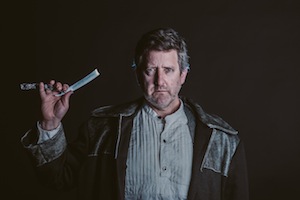Colleen Winton as Mrs. Lovett and Warren Kimmel as Sweeney Todd in Snapshots Collective’s production of Sweeney Todd: The Demon Barber of Fleet Street, which runs Oct. 10-31. (photo by Nicol Spinola)
“To seek revenge may lead to hell, but everyone does it, if seldom as well as Sweeney,” said Stephen Aberle, quoting from the finale of Sweeney Todd: The Demon Barber of Fleet Street. Aberle plays Judge Turpin in the Snapshots Collective production of the musical, which will take place at Mrs. Lovett’s Pie Shop, or at least a facsimile of it, at 348 Water St., in Gastown, Oct. 10-31. Most shows are already sold out.
“Part of the power of the piece,” explained Aberle, whose character sets Sweeney on his murderous path, “is that we can identify with all of the characters, see their strengths and their flaws, and observe how much we share with them. That’s what makes it troubling, that irresistible doubt: would I do anything differently?”
Let’s hope most people would, as Sweeney Todd slits quite a few throats in his barber’s chair – providing the main ingredient for Mrs. Lovett’s pies – before getting to the object of his revenge, Judge Turpin, who abused Sweeney’s wife and exiled Sweeney for a crime Sweeney didn’t commit.
“When we decided on doing Sweeney Todd,” director Chris Adams and choreographer Nicol Spinola told the Independent in an email interview, “we knew we wanted Warren Kimmel as Sweeney, so we approached him first to see if he would be interested in playing the title character. He was on board almost immediately and we started moving forward to cast the rest of the show. We next approached Colleen Winton for the role of Mrs. Lovett and held auditions for the rest of the cast. We weren’t shy in letting auditioning actors know that our show was going to be different and that seemed to excite them. We were thrilled with the turnout and were able to cast the show exactly how we saw it.”
And the intimate audience – theatre capacity is about 56 – will be right in the midst of it all.
“The show is staged around the entire venue with some seats being directly in the action,” said Adams and Spinola, who are also co-producers of the show, with Ron Stuart, Wendy Bross Stuart and Kat Palmer. “There will be interactive moments between the actors and the audience, although there is no audience participation required. Sometimes the action will take place right in front of you and other times the action will be across the room.”
Kimmel looks absolutely terrifying in the production’s 44-second teaser.
“It’s always more fun, interesting, to play dark or evil characters than good ones and, for the most part, I am cast as good guys rather than bad guys so this is fun from that point of view,” said Kimmel of playing the title character in the musical, composed by Stephen Sondheim, with book by Hugh Wheeler. “Also, Sweeney Todd is probably one of the most challenging pieces in the musical canon to perform, so that makes it a stimulating and scary experience as well, which is, I suppose, fun in a twisted fashion.”
“I think this is a tremendously important story for our time,” said Aberle, “a time when the power structures that reinforce men’s privilege and women’s presumed subservience (as well as racialized, class-based and other power imbalances) are being challenged by some; desperately defended by others. We read about Judge Turpin analogues just about every day in the news. I think it’s particularly important for those of us who possess power to check in with a story like this and consider our own exercise of that power. To what extent am I being a self-serving brute in this situation? Are there ways I might reduce that extent? The play, it seems to me, asks questions like those pretty insistently.”
About how he has chosen to portray Judge Turpin, Aberle said, “I’m looking for him the way I generally look for a character: by trying to figure out what he wants in the context of the given circumstances. That context, for a judge in mid-19th-century England, was power, privilege and prestige.
“One of the things that makes Judge Turpin interesting, to me, is that he’s not merely a psychopath or even a simple, spoiled narcissist: he tries to do ‘the right thing’ according to social convention and struggles with his desires (though more because of deeply ingrained inner shame than because he really understands his own power to harm, or empathizes with his victims). There are some questions about the man that I’m interested in exploring. What was his blue-sky vision of the perfect outcome when he set this engine of vengeance rolling, 15 years before the play begins? Why, especially given the power of his urges, has he gone through life so far without marrying? Why did he adopt a year-old infant as his ward? There are several plausible answers – and plausible combinations of multiple answers – for each of these, and I’m enjoying playing with them.”
Echoing Kimmel’s assessment of the music, Aberle added, “And, really, let’s face it. This is Sondheim at just about his Sondheimiest. If I can sing the material more or less in time and on pitch, I’ll be pretty happy.”
“The music plays a central role in telling this story,” Bross Stuart, the show’s musical director, told the Independent, “and there is no one more brilliant than Stephen Sondheim to do this for us. Central to the core of this music is the Gregorian chant, ‘Dies Irae’ (‘Day of Wrath,’ ‘Day of Judgment’) theme, heard throughout this work. We hear fragments of this musical motif hidden everywhere. Extended, shortened, pulled out of shape, but it’s there. We know it is the underpinning of Sweeney Todd’s motivation. It helps us understand Mr. Todd’s state of mind; and how revenge morphs into mental illness. When we are in the asylum, in Act 2, some of the ‘patients’ sing a demented version of ‘Dies Irae.’
“Another example is Sondheim’s use of a repeated note for more than 100 bars. Why does he do this? It is Mr. Todd’s obsession with murdering Judge Turpin. Even while the men are having a seemingly ‘friendly’ conversation, Todd is thinking along more sinister lines.”
“Sweeney Todd, as far as we can tell, is a normal man with a wife he adores and a new young daughter,” said Kimmel. “Without spoiling the plot altogether, life deals him a hand that most would find impossible to survive, let alone overcome, and so we have a perfect vehicle to allow us to ask what we would do in his position and, if we are honest with ourselves and had the courage to follow through, we could easily imagine doing the same things he does.”

But, he added, “In the end, I think it is a very moral story and the final destination is morally inevitable – although we feel for him and want to see him get his revenge, and although he and Mrs. Lovett almost get away with what they have done, it cannot be…. The world is set to rights at the end of the piece.
“You could say that this is just a Victorian melodrama, a deliciously dark tale underlining all the Christian moral virtue of the period,” he continued. “However, like all great drama, I think the rules of the game are timeless – first dramatized in Greek times or even biblical times. You cannot fool God; you cannot escape the price that must be paid for transgressing His rules. There is a fashion now to believe that we have moved past these religious moral strictures and that religion has less to offer a modern society but, in the end, this is a morality tale that resonates with very deep archetypal themes. No matter how justified it may seem, revenge will lead nowhere good.
“From a performance point of view, it is always a gift to be able to play someone truly morally compromised and, in a broader sense, I think that is what the theatre is really for: to allow us to watch this story and go through all that life is able to throw at us, to imagine, to understand and even to justify truly extraordinary behaviour, and yet to laugh and cry and cringe and know that, at the end, the moral compass of the world is back on true north.”
An emotional connection to the show is one of the reasons that the Stuarts wanted to be involved in this production. “We saw the original Broadway production in New York City in 1979, with Angela Lansbury and Len Cariou,” said Ron Stuart. “It was brilliant and riveting and unique in the genre – like West Side Story was 20 years before or Showboat before that.
“Our co-producers had the concept of an immersive version of the show at a Gastown venue around Halloween, and we thought it was an interesting way to present the work.”
In addition to funding, he said, “with projects of this scale, we are also very hands-on. Our director, choreographer, music director and assistant director are also producers. We readily share our contacts in a variety of specialities, such as costumes, set design, lighting, instrument rental, legal issues, marketing, etc. Moreover, we are a collective under Equity rules, so we all have ‘skin in the game.’”
This is Palmer’s first experience as a producer. “It has been nice to learn from professionals who have been through this journey from beginning to end,” she told the Independent.
Knowing that they wanted this show to be immersive, the venue not only had to work from a mechanical perspective, “but add to the experience,” said Palmer, who is also in the ensemble.
“It’s been a fun challenge,” she said, “to be switching between my assistant stage managing hat and my performer hat – ‘this prop will need to be pre-set here, oh no, this is the lyric, this person has a quick change.’”
Palmer described the show as being very difficult technically, “there is not just Stage Left and Stage Right to worry about, there is a whole building.”
This is part of the attraction for Bross Stuart.
“We, the musicians, are very close to the audience and to the actors,” she explained. “Communication, page-turning, singing as you play – could be problematic. And the action is very immediate and very gripping. Very exciting!”
“My favourite number in the show,” said Palmer, “has to be our opening number, ‘The Ballad of Sweeney Todd.’ Our amazing choreographer, Nicol Spinola, has created something so eerie, unique and unsettling. It immediately brings the audience right into this dark and thrilling world of 1840s London. Not only does it sound fantastic to have our entire cast of 17 singing Sondheim’s challenging music, but it also sets the mood for the entire show. I get chills performing it and I am very confident the audience will have never experienced anything like it before.”
For more information and tickets to Sweeney Todd, visit sweeneytoddthemusical.ca. And plan to have dinner at the venue before the show – pies, of course.
“Our pies come fresh each day from the Pie Hole located on Fraser Street in Vancouver,” said Adams and Spinola. “We are offering a traditional steak-and-stout meat pie, an aromatic Moroccan chickpea vegetarian pie and a delicious Thai coconut curry vegan pie. Pies can be added on when you are purchasing your tickets.”

